Disorders of Muscular System and Skeletal System
VerifiedAdded on 2021/12/27
|11
|1976
|19
AI Summary
Contribute Materials
Your contribution can guide someone’s learning journey. Share your
documents today.
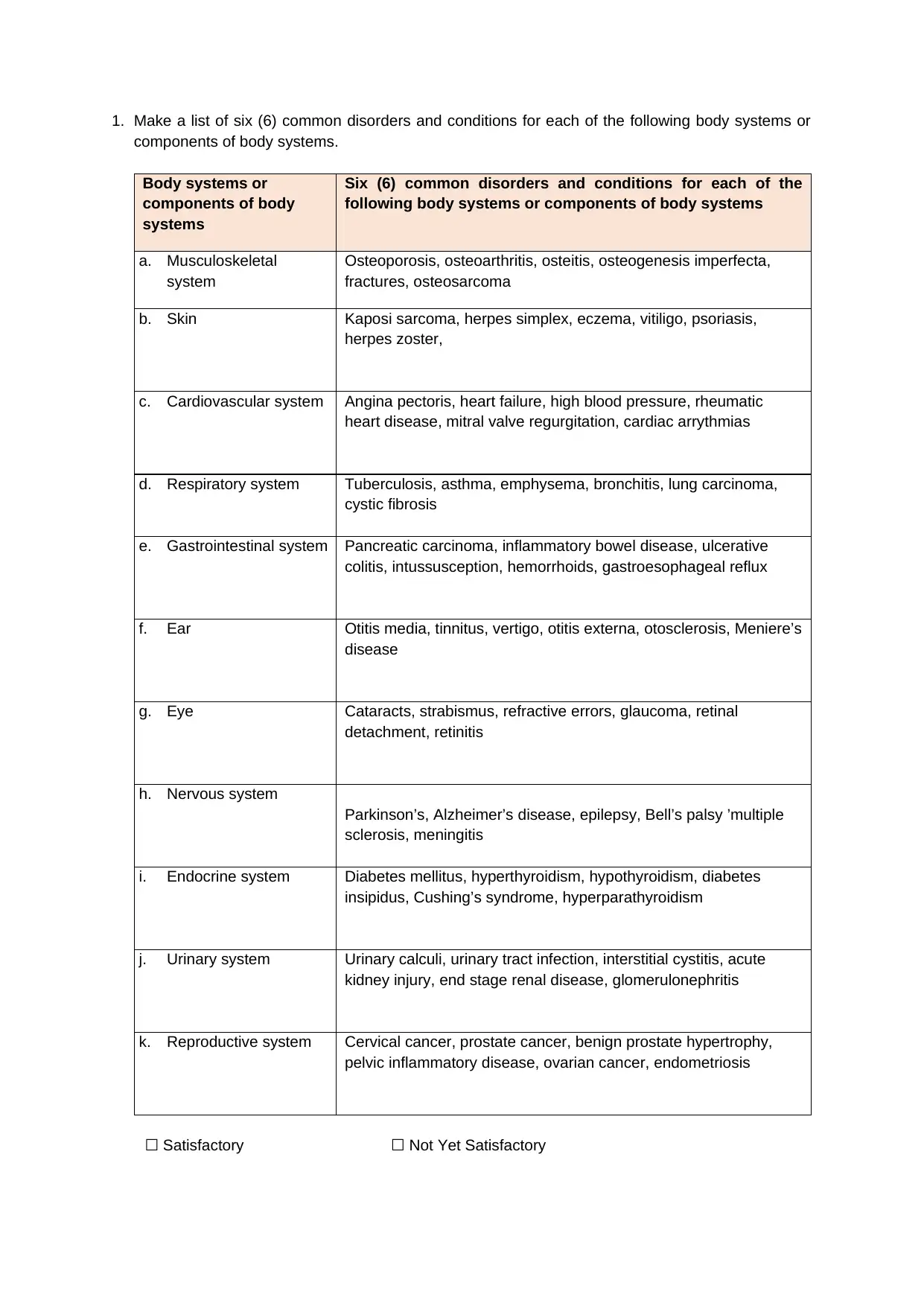
1. Make a list of six (6) common disorders and conditions for each of the following body systems or
components of body systems.
Body systems or
components of body
systems
Six (6) common disorders and conditions for each of the
following body systems or components of body systems
a. Musculoskeletal
system
Osteoporosis, osteoarthritis, osteitis, osteogenesis imperfecta,
fractures, osteosarcoma
b. Skin Kaposi sarcoma, herpes simplex, eczema, vitiligo, psoriasis,
herpes zoster,
c. Cardiovascular system Angina pectoris, heart failure, high blood pressure, rheumatic
heart disease, mitral valve regurgitation, cardiac arrythmias
d. Respiratory system Tuberculosis, asthma, emphysema, bronchitis, lung carcinoma,
cystic fibrosis
e. Gastrointestinal system Pancreatic carcinoma, inflammatory bowel disease, ulcerative
colitis, intussusception, hemorrhoids, gastroesophageal reflux
f. Ear Otitis media, tinnitus, vertigo, otitis externa, otosclerosis, Meniere’s
disease
g. Eye Cataracts, strabismus, refractive errors, glaucoma, retinal
detachment, retinitis
h. Nervous system
Parkinson’s, Alzheimer’s disease, epilepsy, Bell’s palsy ’multiple
sclerosis, meningitis
i. Endocrine system Diabetes mellitus, hyperthyroidism, hypothyroidism, diabetes
insipidus, Cushing’s syndrome, hyperparathyroidism
j. Urinary system Urinary calculi, urinary tract infection, interstitial cystitis, acute
kidney injury, end stage renal disease, glomerulonephritis
k. Reproductive system Cervical cancer, prostate cancer, benign prostate hypertrophy,
pelvic inflammatory disease, ovarian cancer, endometriosis
Satisfactory☐ Not Yet Satisfactory☐
components of body systems.
Body systems or
components of body
systems
Six (6) common disorders and conditions for each of the
following body systems or components of body systems
a. Musculoskeletal
system
Osteoporosis, osteoarthritis, osteitis, osteogenesis imperfecta,
fractures, osteosarcoma
b. Skin Kaposi sarcoma, herpes simplex, eczema, vitiligo, psoriasis,
herpes zoster,
c. Cardiovascular system Angina pectoris, heart failure, high blood pressure, rheumatic
heart disease, mitral valve regurgitation, cardiac arrythmias
d. Respiratory system Tuberculosis, asthma, emphysema, bronchitis, lung carcinoma,
cystic fibrosis
e. Gastrointestinal system Pancreatic carcinoma, inflammatory bowel disease, ulcerative
colitis, intussusception, hemorrhoids, gastroesophageal reflux
f. Ear Otitis media, tinnitus, vertigo, otitis externa, otosclerosis, Meniere’s
disease
g. Eye Cataracts, strabismus, refractive errors, glaucoma, retinal
detachment, retinitis
h. Nervous system
Parkinson’s, Alzheimer’s disease, epilepsy, Bell’s palsy ’multiple
sclerosis, meningitis
i. Endocrine system Diabetes mellitus, hyperthyroidism, hypothyroidism, diabetes
insipidus, Cushing’s syndrome, hyperparathyroidism
j. Urinary system Urinary calculi, urinary tract infection, interstitial cystitis, acute
kidney injury, end stage renal disease, glomerulonephritis
k. Reproductive system Cervical cancer, prostate cancer, benign prostate hypertrophy,
pelvic inflammatory disease, ovarian cancer, endometriosis
Satisfactory☐ Not Yet Satisfactory☐
Secure Best Marks with AI Grader
Need help grading? Try our AI Grader for instant feedback on your assignments.
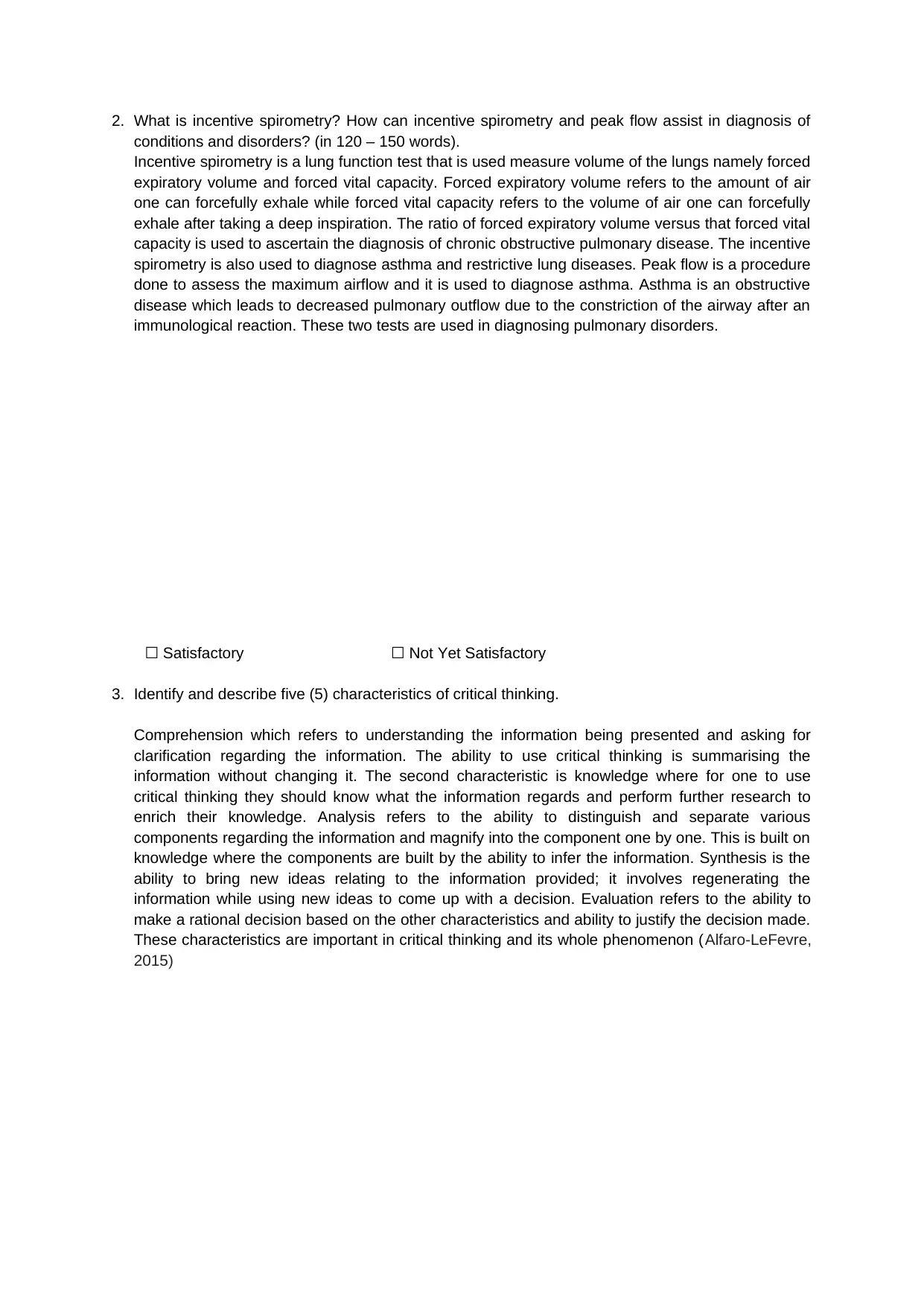
2. What is incentive spirometry? How can incentive spirometry and peak flow assist in diagnosis of
conditions and disorders? (in 120 – 150 words).
Incentive spirometry is a lung function test that is used measure volume of the lungs namely forced
expiratory volume and forced vital capacity. Forced expiratory volume refers to the amount of air
one can forcefully exhale while forced vital capacity refers to the volume of air one can forcefully
exhale after taking a deep inspiration. The ratio of forced expiratory volume versus that forced vital
capacity is used to ascertain the diagnosis of chronic obstructive pulmonary disease. The incentive
spirometry is also used to diagnose asthma and restrictive lung diseases. Peak flow is a procedure
done to assess the maximum airflow and it is used to diagnose asthma. Asthma is an obstructive
disease which leads to decreased pulmonary outflow due to the constriction of the airway after an
immunological reaction. These two tests are used in diagnosing pulmonary disorders.
Satisfactory☐ Not Yet Satisfactory☐
3. Identify and describe five (5) characteristics of critical thinking.
Comprehension which refers to understanding the information being presented and asking for
clarification regarding the information. The ability to use critical thinking is summarising the
information without changing it. The second characteristic is knowledge where for one to use
critical thinking they should know what the information regards and perform further research to
enrich their knowledge. Analysis refers to the ability to distinguish and separate various
components regarding the information and magnify into the component one by one. This is built on
knowledge where the components are built by the ability to infer the information. Synthesis is the
ability to bring new ideas relating to the information provided; it involves regenerating the
information while using new ideas to come up with a decision. Evaluation refers to the ability to
make a rational decision based on the other characteristics and ability to justify the decision made.
These characteristics are important in critical thinking and its whole phenomenon (Alfaro-LeFevre,
2015)
conditions and disorders? (in 120 – 150 words).
Incentive spirometry is a lung function test that is used measure volume of the lungs namely forced
expiratory volume and forced vital capacity. Forced expiratory volume refers to the amount of air
one can forcefully exhale while forced vital capacity refers to the volume of air one can forcefully
exhale after taking a deep inspiration. The ratio of forced expiratory volume versus that forced vital
capacity is used to ascertain the diagnosis of chronic obstructive pulmonary disease. The incentive
spirometry is also used to diagnose asthma and restrictive lung diseases. Peak flow is a procedure
done to assess the maximum airflow and it is used to diagnose asthma. Asthma is an obstructive
disease which leads to decreased pulmonary outflow due to the constriction of the airway after an
immunological reaction. These two tests are used in diagnosing pulmonary disorders.
Satisfactory☐ Not Yet Satisfactory☐
3. Identify and describe five (5) characteristics of critical thinking.
Comprehension which refers to understanding the information being presented and asking for
clarification regarding the information. The ability to use critical thinking is summarising the
information without changing it. The second characteristic is knowledge where for one to use
critical thinking they should know what the information regards and perform further research to
enrich their knowledge. Analysis refers to the ability to distinguish and separate various
components regarding the information and magnify into the component one by one. This is built on
knowledge where the components are built by the ability to infer the information. Synthesis is the
ability to bring new ideas relating to the information provided; it involves regenerating the
information while using new ideas to come up with a decision. Evaluation refers to the ability to
make a rational decision based on the other characteristics and ability to justify the decision made.
These characteristics are important in critical thinking and its whole phenomenon (Alfaro-LeFevre,
2015)

Satisfactory☐ Not Yet Satisfactory☐
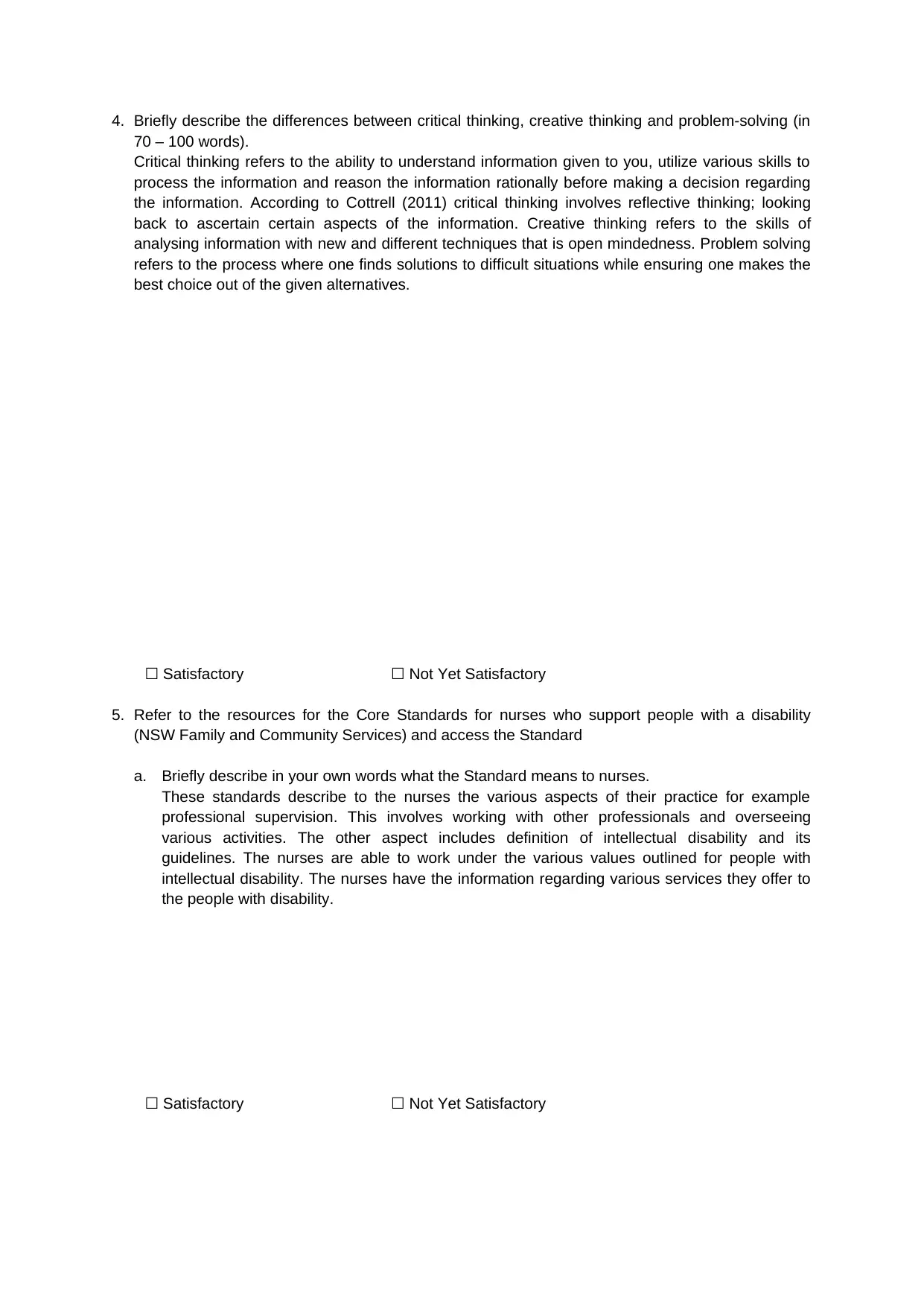
4. Briefly describe the differences between critical thinking, creative thinking and problem-solving (in
70 – 100 words).
Critical thinking refers to the ability to understand information given to you, utilize various skills to
process the information and reason the information rationally before making a decision regarding
the information. According to Cottrell (2011) critical thinking involves reflective thinking; looking
back to ascertain certain aspects of the information. Creative thinking refers to the skills of
analysing information with new and different techniques that is open mindedness. Problem solving
refers to the process where one finds solutions to difficult situations while ensuring one makes the
best choice out of the given alternatives.
Satisfactory☐ Not Yet Satisfactory☐
5. Refer to the resources for the Core Standards for nurses who support people with a disability
(NSW Family and Community Services) and access the Standard
a. Briefly describe in your own words what the Standard means to nurses.
These standards describe to the nurses the various aspects of their practice for example
professional supervision. This involves working with other professionals and overseeing
various activities. The other aspect includes definition of intellectual disability and its
guidelines. The nurses are able to work under the various values outlined for people with
intellectual disability. The nurses have the information regarding various services they offer to
the people with disability.
Satisfactory☐ Not Yet Satisfactory☐
70 – 100 words).
Critical thinking refers to the ability to understand information given to you, utilize various skills to
process the information and reason the information rationally before making a decision regarding
the information. According to Cottrell (2011) critical thinking involves reflective thinking; looking
back to ascertain certain aspects of the information. Creative thinking refers to the skills of
analysing information with new and different techniques that is open mindedness. Problem solving
refers to the process where one finds solutions to difficult situations while ensuring one makes the
best choice out of the given alternatives.
Satisfactory☐ Not Yet Satisfactory☐
5. Refer to the resources for the Core Standards for nurses who support people with a disability
(NSW Family and Community Services) and access the Standard
a. Briefly describe in your own words what the Standard means to nurses.
These standards describe to the nurses the various aspects of their practice for example
professional supervision. This involves working with other professionals and overseeing
various activities. The other aspect includes definition of intellectual disability and its
guidelines. The nurses are able to work under the various values outlined for people with
intellectual disability. The nurses have the information regarding various services they offer to
the people with disability.
Satisfactory☐ Not Yet Satisfactory☐
Secure Best Marks with AI Grader
Need help grading? Try our AI Grader for instant feedback on your assignments.
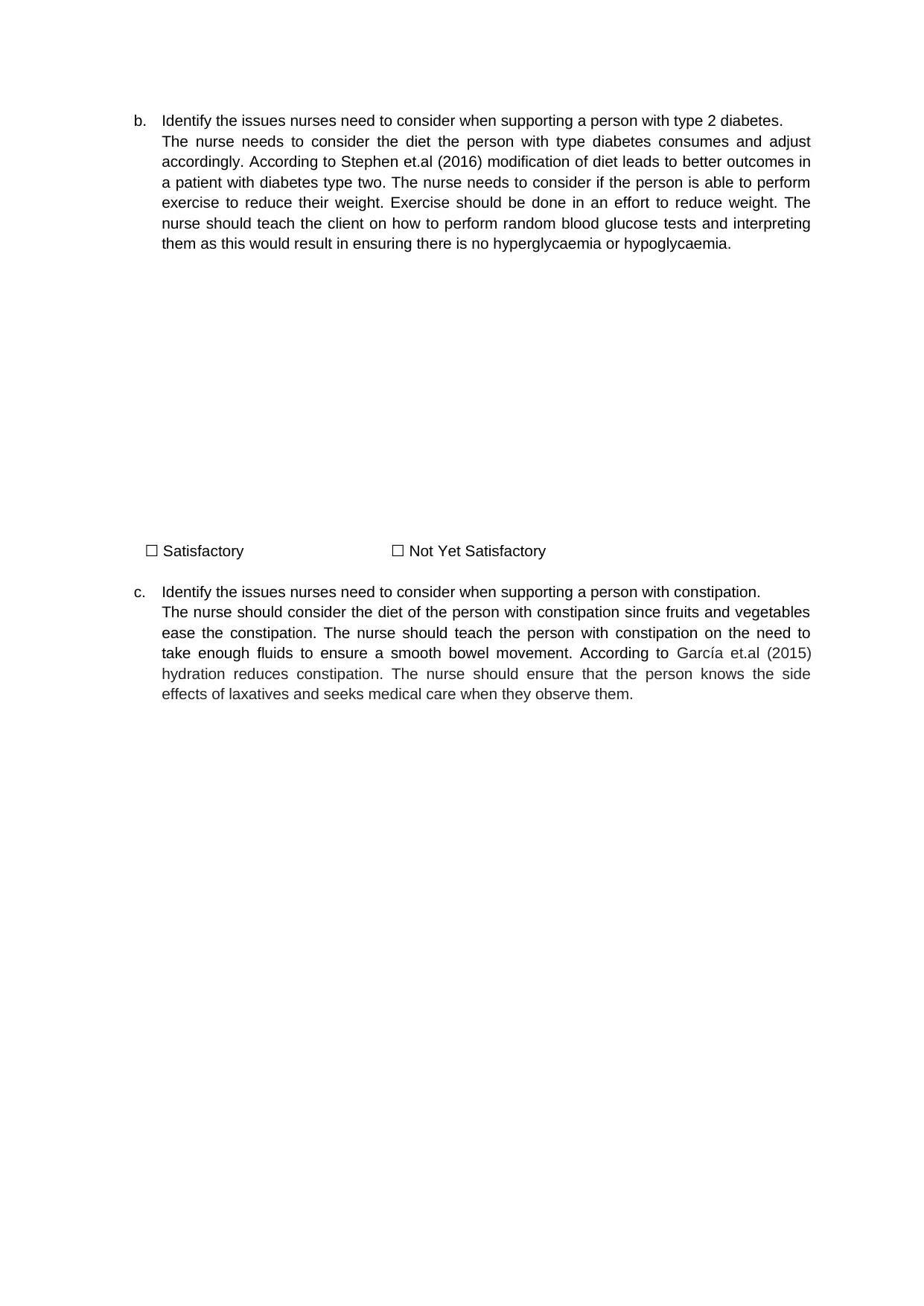
b. Identify the issues nurses need to consider when supporting a person with type 2 diabetes.
The nurse needs to consider the diet the person with type diabetes consumes and adjust
accordingly. According to Stephen et.al (2016) modification of diet leads to better outcomes in
a patient with diabetes type two. The nurse needs to consider if the person is able to perform
exercise to reduce their weight. Exercise should be done in an effort to reduce weight. The
nurse should teach the client on how to perform random blood glucose tests and interpreting
them as this would result in ensuring there is no hyperglycaemia or hypoglycaemia.
Satisfactory☐ Not Yet Satisfactory☐
c. Identify the issues nurses need to consider when supporting a person with constipation.
The nurse should consider the diet of the person with constipation since fruits and vegetables
ease the constipation. The nurse should teach the person with constipation on the need to
take enough fluids to ensure a smooth bowel movement. According to García et.al (2015)
hydration reduces constipation. The nurse should ensure that the person knows the side
effects of laxatives and seeks medical care when they observe them.
The nurse needs to consider the diet the person with type diabetes consumes and adjust
accordingly. According to Stephen et.al (2016) modification of diet leads to better outcomes in
a patient with diabetes type two. The nurse needs to consider if the person is able to perform
exercise to reduce their weight. Exercise should be done in an effort to reduce weight. The
nurse should teach the client on how to perform random blood glucose tests and interpreting
them as this would result in ensuring there is no hyperglycaemia or hypoglycaemia.
Satisfactory☐ Not Yet Satisfactory☐
c. Identify the issues nurses need to consider when supporting a person with constipation.
The nurse should consider the diet of the person with constipation since fruits and vegetables
ease the constipation. The nurse should teach the person with constipation on the need to
take enough fluids to ensure a smooth bowel movement. According to García et.al (2015)
hydration reduces constipation. The nurse should ensure that the person knows the side
effects of laxatives and seeks medical care when they observe them.

Satisfactory☐ Not Yet Satisfactory☐
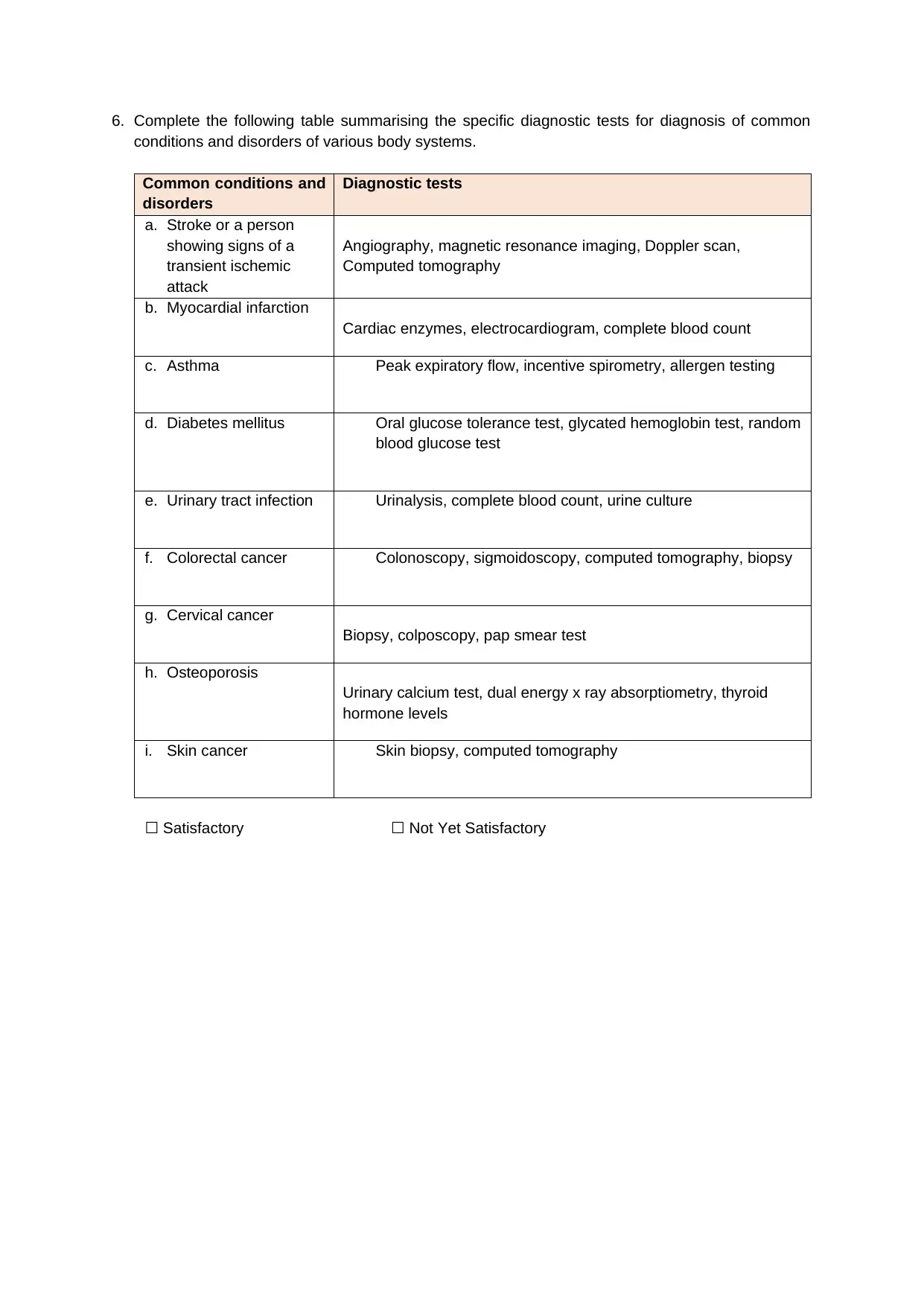
6. Complete the following table summarising the specific diagnostic tests for diagnosis of common
conditions and disorders of various body systems.
Common conditions and
disorders
Diagnostic tests
a. Stroke or a person
showing signs of a
transient ischemic
attack
Angiography, magnetic resonance imaging, Doppler scan,
Computed tomography
b. Myocardial infarction
Cardiac enzymes, electrocardiogram, complete blood count
c. Asthma Peak expiratory flow, incentive spirometry, allergen testing
d. Diabetes mellitus Oral glucose tolerance test, glycated hemoglobin test, random
blood glucose test
e. Urinary tract infection Urinalysis, complete blood count, urine culture
f. Colorectal cancer Colonoscopy, sigmoidoscopy, computed tomography, biopsy
g. Cervical cancer
Biopsy, colposcopy, pap smear test
h. Osteoporosis
Urinary calcium test, dual energy x ray absorptiometry, thyroid
hormone levels
i. Skin cancer Skin biopsy, computed tomography
Satisfactory☐ Not Yet Satisfactory☐
conditions and disorders of various body systems.
Common conditions and
disorders
Diagnostic tests
a. Stroke or a person
showing signs of a
transient ischemic
attack
Angiography, magnetic resonance imaging, Doppler scan,
Computed tomography
b. Myocardial infarction
Cardiac enzymes, electrocardiogram, complete blood count
c. Asthma Peak expiratory flow, incentive spirometry, allergen testing
d. Diabetes mellitus Oral glucose tolerance test, glycated hemoglobin test, random
blood glucose test
e. Urinary tract infection Urinalysis, complete blood count, urine culture
f. Colorectal cancer Colonoscopy, sigmoidoscopy, computed tomography, biopsy
g. Cervical cancer
Biopsy, colposcopy, pap smear test
h. Osteoporosis
Urinary calcium test, dual energy x ray absorptiometry, thyroid
hormone levels
i. Skin cancer Skin biopsy, computed tomography
Satisfactory☐ Not Yet Satisfactory☐
Paraphrase This Document
Need a fresh take? Get an instant paraphrase of this document with our AI Paraphraser
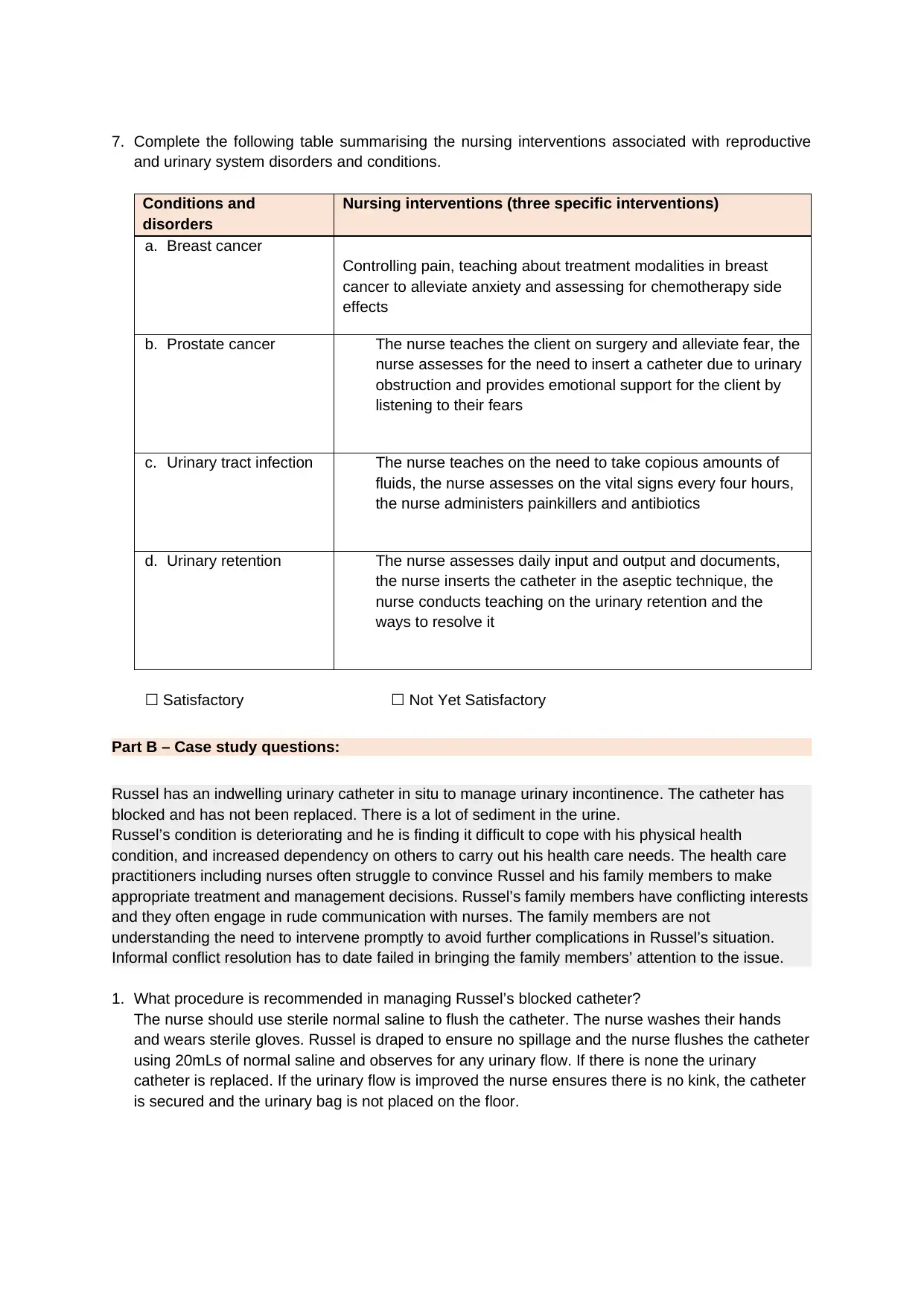
7. Complete the following table summarising the nursing interventions associated with reproductive
and urinary system disorders and conditions.
Conditions and
disorders
Nursing interventions (three specific interventions)
a. Breast cancer
Controlling pain, teaching about treatment modalities in breast
cancer to alleviate anxiety and assessing for chemotherapy side
effects
b. Prostate cancer The nurse teaches the client on surgery and alleviate fear, the
nurse assesses for the need to insert a catheter due to urinary
obstruction and provides emotional support for the client by
listening to their fears
c. Urinary tract infection The nurse teaches on the need to take copious amounts of
fluids, the nurse assesses on the vital signs every four hours,
the nurse administers painkillers and antibiotics
d. Urinary retention The nurse assesses daily input and output and documents,
the nurse inserts the catheter in the aseptic technique, the
nurse conducts teaching on the urinary retention and the
ways to resolve it
Satisfactory☐ Not Yet Satisfactory☐
Part B – Case study questions:
Russel has an indwelling urinary catheter in situ to manage urinary incontinence. The catheter has
blocked and has not been replaced. There is a lot of sediment in the urine.
Russel’s condition is deteriorating and he is finding it difficult to cope with his physical health
condition, and increased dependency on others to carry out his health care needs. The health care
practitioners including nurses often struggle to convince Russel and his family members to make
appropriate treatment and management decisions. Russel’s family members have conflicting interests
and they often engage in rude communication with nurses. The family members are not
understanding the need to intervene promptly to avoid further complications in Russel’s situation.
Informal conflict resolution has to date failed in bringing the family members’ attention to the issue.
1. What procedure is recommended in managing Russel’s blocked catheter?
The nurse should use sterile normal saline to flush the catheter. The nurse washes their hands
and wears sterile gloves. Russel is draped to ensure no spillage and the nurse flushes the catheter
using 20mLs of normal saline and observes for any urinary flow. If there is none the urinary
catheter is replaced. If the urinary flow is improved the nurse ensures there is no kink, the catheter
is secured and the urinary bag is not placed on the floor.
and urinary system disorders and conditions.
Conditions and
disorders
Nursing interventions (three specific interventions)
a. Breast cancer
Controlling pain, teaching about treatment modalities in breast
cancer to alleviate anxiety and assessing for chemotherapy side
effects
b. Prostate cancer The nurse teaches the client on surgery and alleviate fear, the
nurse assesses for the need to insert a catheter due to urinary
obstruction and provides emotional support for the client by
listening to their fears
c. Urinary tract infection The nurse teaches on the need to take copious amounts of
fluids, the nurse assesses on the vital signs every four hours,
the nurse administers painkillers and antibiotics
d. Urinary retention The nurse assesses daily input and output and documents,
the nurse inserts the catheter in the aseptic technique, the
nurse conducts teaching on the urinary retention and the
ways to resolve it
Satisfactory☐ Not Yet Satisfactory☐
Part B – Case study questions:
Russel has an indwelling urinary catheter in situ to manage urinary incontinence. The catheter has
blocked and has not been replaced. There is a lot of sediment in the urine.
Russel’s condition is deteriorating and he is finding it difficult to cope with his physical health
condition, and increased dependency on others to carry out his health care needs. The health care
practitioners including nurses often struggle to convince Russel and his family members to make
appropriate treatment and management decisions. Russel’s family members have conflicting interests
and they often engage in rude communication with nurses. The family members are not
understanding the need to intervene promptly to avoid further complications in Russel’s situation.
Informal conflict resolution has to date failed in bringing the family members’ attention to the issue.
1. What procedure is recommended in managing Russel’s blocked catheter?
The nurse should use sterile normal saline to flush the catheter. The nurse washes their hands
and wears sterile gloves. Russel is draped to ensure no spillage and the nurse flushes the catheter
using 20mLs of normal saline and observes for any urinary flow. If there is none the urinary
catheter is replaced. If the urinary flow is improved the nurse ensures there is no kink, the catheter
is secured and the urinary bag is not placed on the floor.
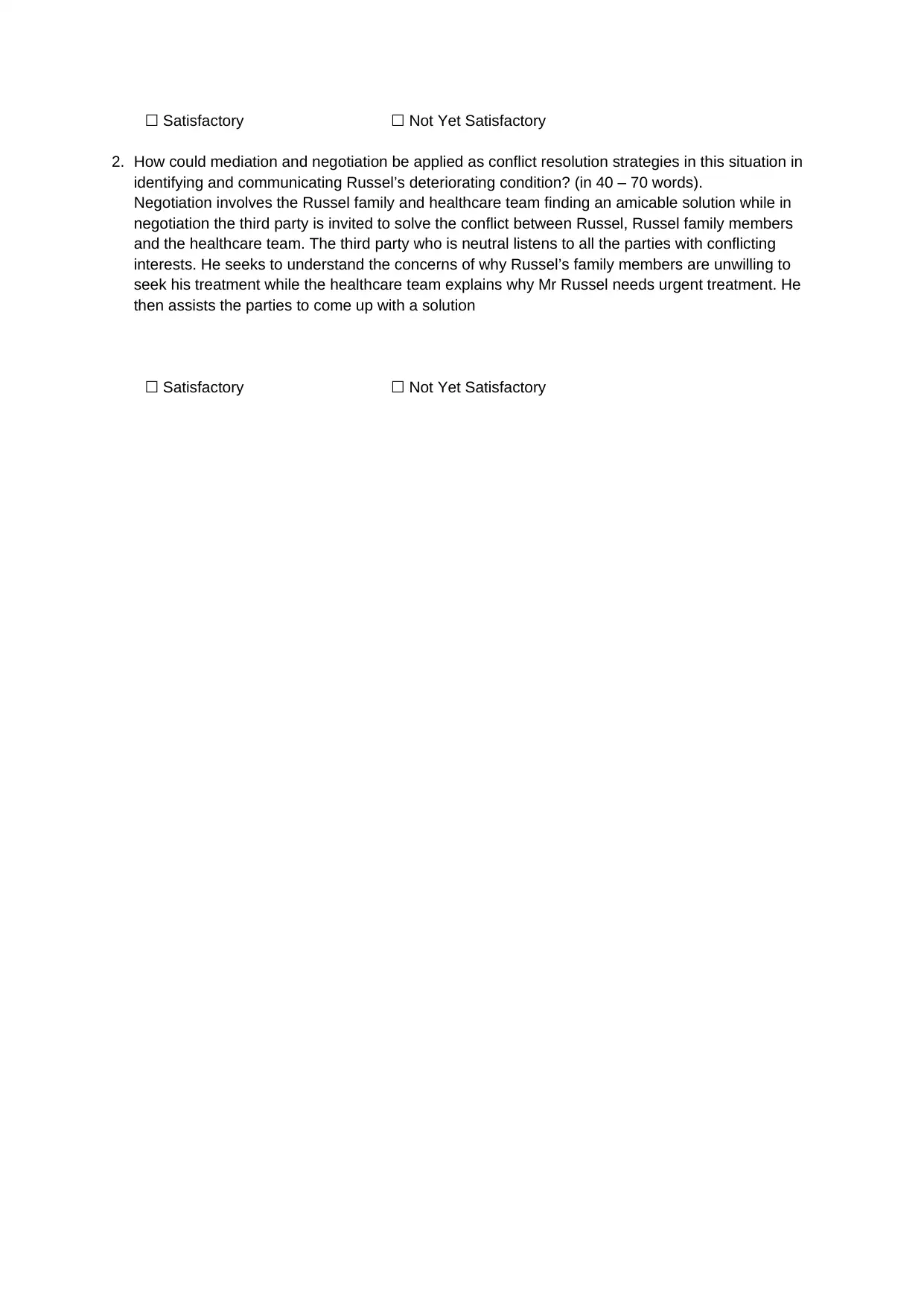
Satisfactory☐ Not Yet Satisfactory☐
2. How could mediation and negotiation be applied as conflict resolution strategies in this situation in
identifying and communicating Russel’s deteriorating condition? (in 40 – 70 words).
Negotiation involves the Russel family and healthcare team finding an amicable solution while in
negotiation the third party is invited to solve the conflict between Russel, Russel family members
and the healthcare team. The third party who is neutral listens to all the parties with conflicting
interests. He seeks to understand the concerns of why Russel’s family members are unwilling to
seek his treatment while the healthcare team explains why Mr Russel needs urgent treatment. He
then assists the parties to come up with a solution
Satisfactory☐ Not Yet Satisfactory☐
2. How could mediation and negotiation be applied as conflict resolution strategies in this situation in
identifying and communicating Russel’s deteriorating condition? (in 40 – 70 words).
Negotiation involves the Russel family and healthcare team finding an amicable solution while in
negotiation the third party is invited to solve the conflict between Russel, Russel family members
and the healthcare team. The third party who is neutral listens to all the parties with conflicting
interests. He seeks to understand the concerns of why Russel’s family members are unwilling to
seek his treatment while the healthcare team explains why Mr Russel needs urgent treatment. He
then assists the parties to come up with a solution
Satisfactory☐ Not Yet Satisfactory☐
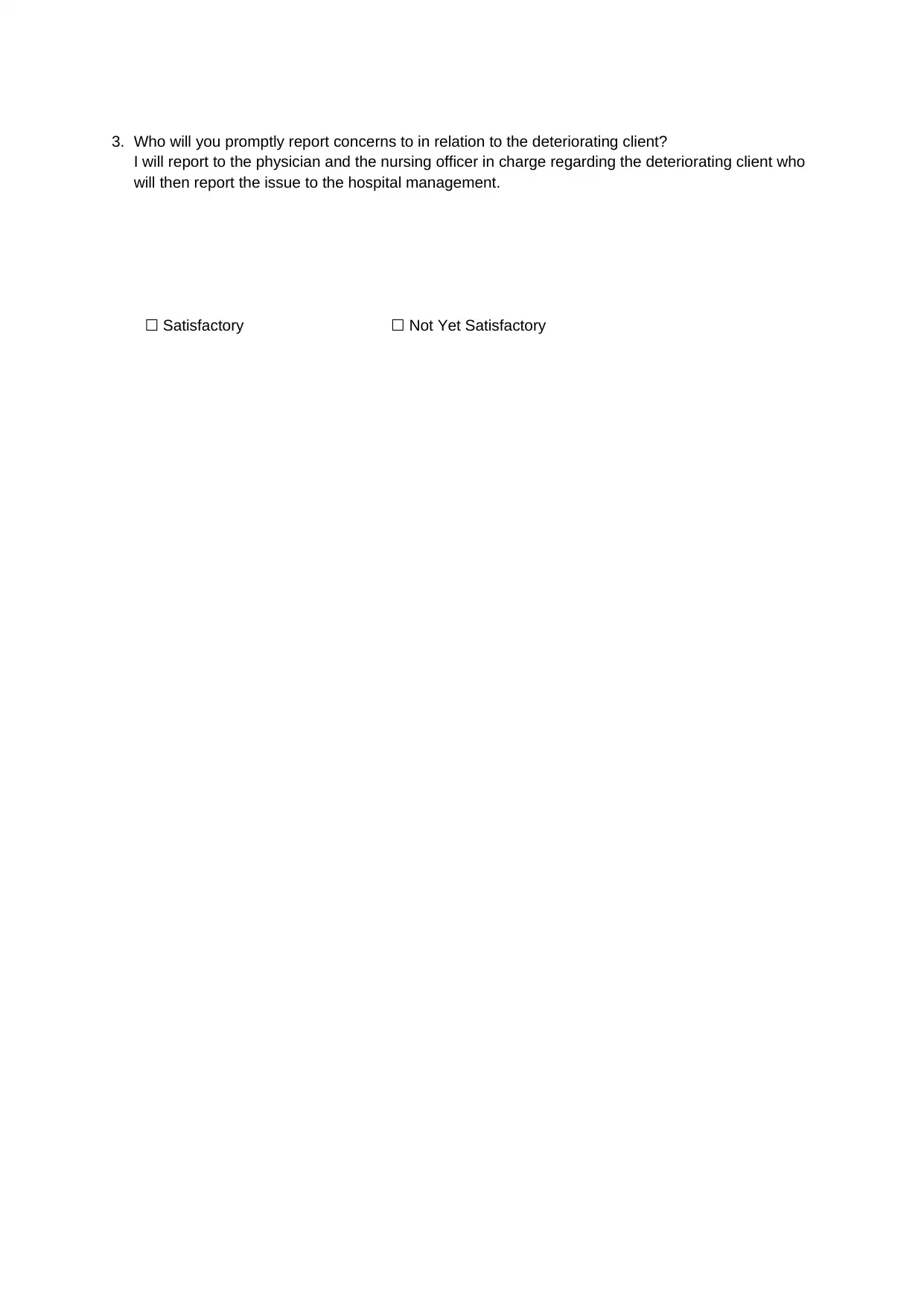
3. Who will you promptly report concerns to in relation to the deteriorating client?
I will report to the physician and the nursing officer in charge regarding the deteriorating client who
will then report the issue to the hospital management.
Satisfactory☐ Not Yet Satisfactory☐
I will report to the physician and the nursing officer in charge regarding the deteriorating client who
will then report the issue to the hospital management.
Satisfactory☐ Not Yet Satisfactory☐
Secure Best Marks with AI Grader
Need help grading? Try our AI Grader for instant feedback on your assignments.
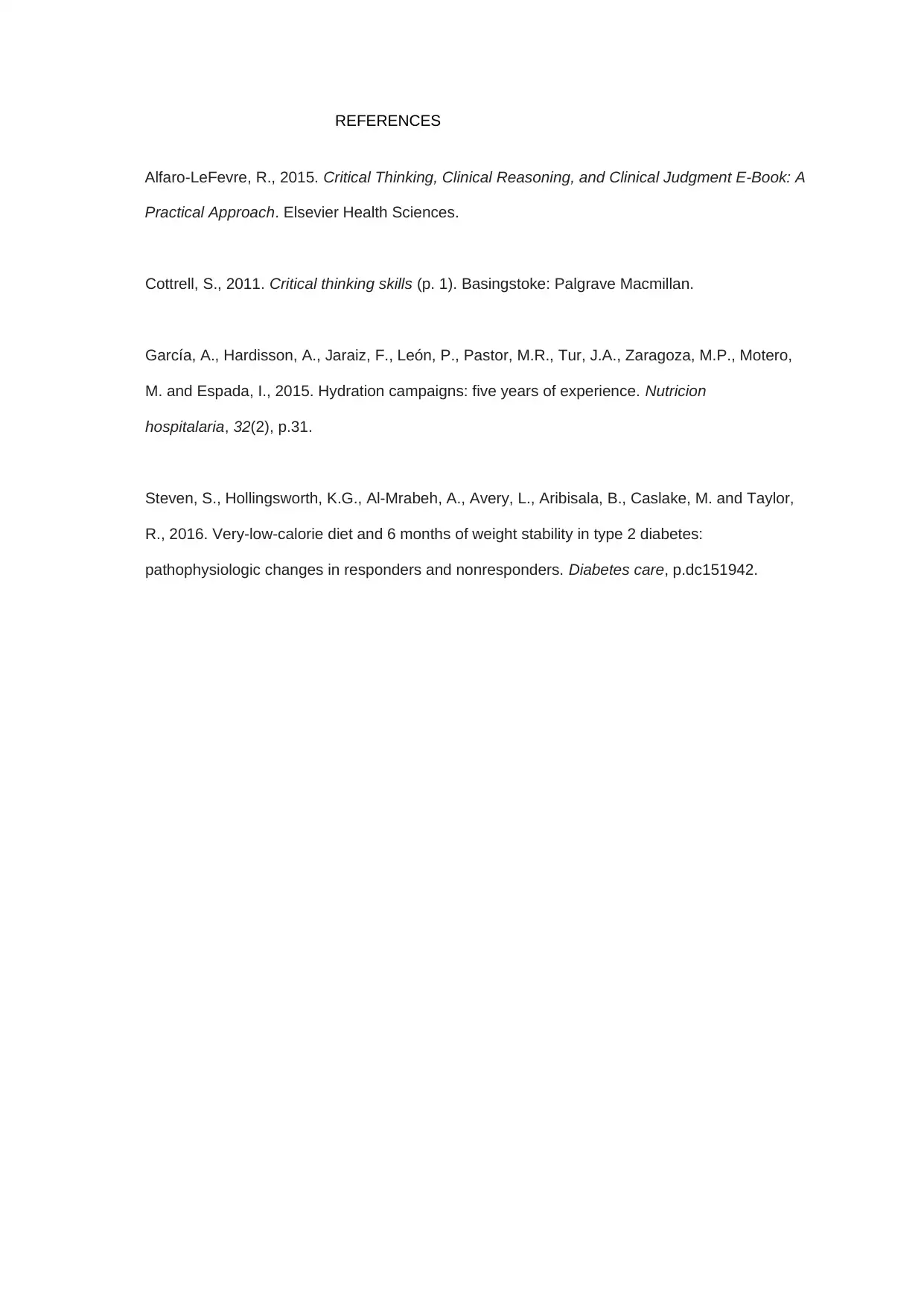
REFERENCES
Alfaro-LeFevre, R., 2015. Critical Thinking, Clinical Reasoning, and Clinical Judgment E-Book: A
Practical Approach. Elsevier Health Sciences.
Cottrell, S., 2011. Critical thinking skills (p. 1). Basingstoke: Palgrave Macmillan.
García, A., Hardisson, A., Jaraiz, F., León, P., Pastor, M.R., Tur, J.A., Zaragoza, M.P., Motero,
M. and Espada, I., 2015. Hydration campaigns: five years of experience. Nutricion
hospitalaria, 32(2), p.31.
Steven, S., Hollingsworth, K.G., Al-Mrabeh, A., Avery, L., Aribisala, B., Caslake, M. and Taylor,
R., 2016. Very-low-calorie diet and 6 months of weight stability in type 2 diabetes:
pathophysiologic changes in responders and nonresponders. Diabetes care, p.dc151942.
Alfaro-LeFevre, R., 2015. Critical Thinking, Clinical Reasoning, and Clinical Judgment E-Book: A
Practical Approach. Elsevier Health Sciences.
Cottrell, S., 2011. Critical thinking skills (p. 1). Basingstoke: Palgrave Macmillan.
García, A., Hardisson, A., Jaraiz, F., León, P., Pastor, M.R., Tur, J.A., Zaragoza, M.P., Motero,
M. and Espada, I., 2015. Hydration campaigns: five years of experience. Nutricion
hospitalaria, 32(2), p.31.
Steven, S., Hollingsworth, K.G., Al-Mrabeh, A., Avery, L., Aribisala, B., Caslake, M. and Taylor,
R., 2016. Very-low-calorie diet and 6 months of weight stability in type 2 diabetes:
pathophysiologic changes in responders and nonresponders. Diabetes care, p.dc151942.
1 out of 11
Your All-in-One AI-Powered Toolkit for Academic Success.
+13062052269
info@desklib.com
Available 24*7 on WhatsApp / Email
![[object Object]](/_next/static/media/star-bottom.7253800d.svg)
Unlock your academic potential
© 2024 | Zucol Services PVT LTD | All rights reserved.
